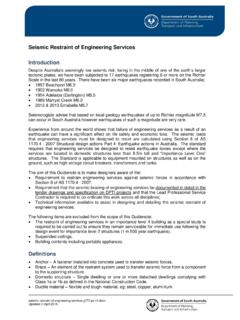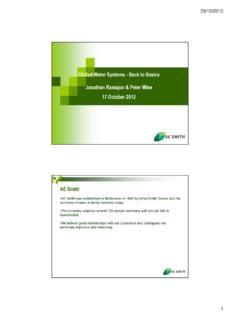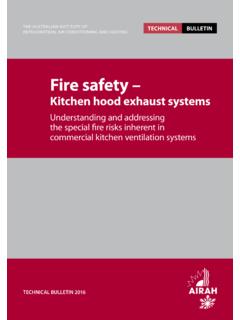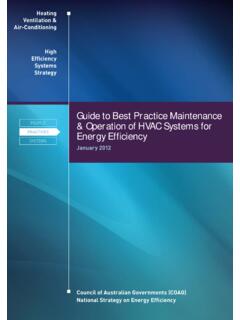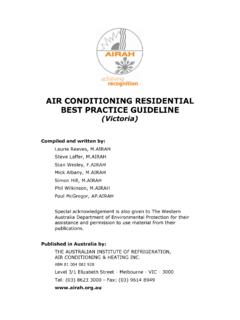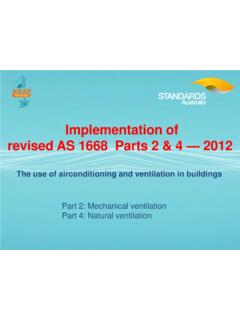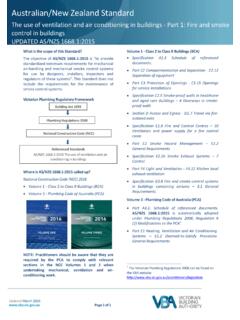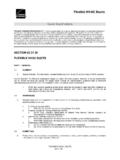Transcription of Feature ALL ABOUT DUCTS - AIRAH
1 10 | HVAC&R Nation | | September 2015 Insulated flexible duct is the most commonly used material in modern residential HVAC duct systems, with an estimated 38 per cent of all household energy consumption related to space heating involving flexible , with such widespread use also comes the inevitable downsides, including that under insulated, poor performing ductwork can result in energy losses of 30 per begs the question what is being done ABOUT it?The answer is far back as 2006, the federal government identified non-compliance issues and the energy losses associated with poor performing ductwork, and legislated national minimum requirements for flexible duct of how is customer to know precisely what ductwork has been installed under their home? And moreover, who is checking?According to Cameron Chick, , from Acronem Consulting Australia, while legislation exists to govern aspects of the regulation necessary for the Australian flexible duct industry, consumers are unwittingly continuing to pay for the installation of non-conforming flexible duct that will not deliver the promised , it can go undetected for the life of the mandatory labelling requires the manufacturers name, compliance with AS and the R-value to be repeated every 1000mm along all flexible DUCTS , the prevalence of non-conforming flexible duct continues to plague the prompted Insulation Australasia (IA) to commission Acronem Consulting Australia to conduct a survey of the thermal performance of flexible was not surprised at what the survey revealed.
2 Feature ALL ABOUTDUCTSD espite efforts by industry stakeholders and watchdogs, non-conforming ductwork continues to plague the marketplace. A recent survey found that all nine samples of flexible duct failed to achieve their stated performance, as Sean McGowan there a light at the end of the tunnel when it comes to the problem of non-conforming ductwork? September 2015 | | HVAC&R Nation | 11 ELEPHANT UNDER THE HOUSEThe report, A Survey of Thermal Performance of Flexible duct , was released in May last year and was based on testing the thermal efficiency of nine randomly selected insulated flexible DUCTS produced by different manufacturers, all of which were readily available in Australia. Unsurprisingly, all samples failed to achieve their stated performance, says to the report, nine 6m lengths of flexible duct were sourced for the purpose of conducting physical measurements and thermal resistance testing at CSIRO Infrastructure Technologies Thermal Test duct tested was all 300mm in diameter with a material R-value of no consensus existing as to the specific test method or standard for finished or as-sold, flexible duct , all nine samples were instead examined in accordance with ASTM C518 Standard Test Method for Steady-State Thermal Transmission Properties (the referenced testing regime for AS/NZS Materials for the Thermal Insulation of Buildings)
3 Using calibrated heat flow basic construction of the nine flexible duct samples consisted of an outer sheath, insulation layer and inner nine tests of the like samples revealed that they achieved an average R-value of (m K/W), with a standard deviation of (m K/W).The best performing sample achieved The worst achieved just such, each sample failed to meet the existing minimum mandatory thermal performance provisions as specified in the National Construction Code (NCC). To a large degree, the measured mean thermal resistance can be attributed to the critical material characteristics of thickness and density, says the report. In seven of nine specimens, the measured Annulus Gap (radial) was less than the insulation thickness. Where the available Annulus Gap (radial) between the outer sheath and the inner core is less than the thickness, the effectiveness of the insulation is reduced.
4 The largest measured reduction in thickness was 32 per cent, which corresponded to a measured mean thermal resistance (R-value) of 33 per cent less than the declared material R-value. While the obvious solution to manufacture the outer sheath and inner core to allow an Annulus Gap large enough to allow full thickness recovery of the insulation, this will result in a significant gap between the insulation and the outer sheath until the insulation has had sufficient time to recover, the report says that while the insulation blanket is loose within the flexible duct , the likelihood of longitudinal gaps forming between the join in the insulation increases. These gaps will reduce the overall thermal performance of the flexible duct by a significant THE GAPThe high degree of fragmentation and competition in the Australian flexible duct market together with enforcement of regulatory requirements remain the largest obstacles to improving the thermal performance of flexible duct .
5 This has prompted the industry, represented through the Australian duct Manufacturers Association (ADMA), to raise concerns over the consistency and quality of flexible duct in relation to construction, fire standards, labelling and thermal performance. These concerns were brought to the attention of the Department of Climate Change and the Australian Competition and Consumer Commission (ACCC) last year, with the expectation that this sector of the industry will be more closely policed for compliance to the BCA. Product compliance is not optional, says Chick. Whilst failures in flexible ductwork are not as sexy as fire propagation up a building fa ade, or the catastrophic structural collapse of pallet racking, make no mistake that all materials supplied to meet regulatory requirements are under much greater scrutiny. Demonstration of performance is the end goal of regulators, and the end-user.
6 Chick says industry members who work with flexible duct would benefit greatly from completing ADMA s newly developed online E Learning program has been designed to bring industry members up to speed with the current regulations AS , that came into effect on May 1, has been designed not only for apprentices, qualified plumbers, duct installers and duct manufacturers/importers, but also for architects, specifiers, regulators, councils and authorities. Everyone has a part to play, says Make sure you do not have to remove and replace non-compliant flexible duct at your cost, says recommends asking the duct supplier to email you the mandatory Flexible duct Compliance Report Summary for each type of flexible duct being supplied on a this report on your phone for times when you will be asked to produce and oversupplyOf course, flexible duct is not the only product used by the HVAC ductwork is used to a much greater scale in the commercial sector, where it is fabricated according to the specifications of the build.
7 But it s not immune to the same problems of non-compliance that exist in the flexible duct the extremely competitive nature of the industry seems partly to blame. At times, there is an oversupply which puts pressure on prices and quality of duct , says Darren Davies from Baron Insulation, one of Australia s leading insulation suppliers to the HVAC says some sheet metal duct shops are operating with a high volume-low margin mentality, which can result in non-compliant duct through under-specified insulation and at times low-level workmanship with thinner gauge material. In a competitive market place non-conforming duct can quickly grow market share, making the conforming product more costly due to reduced volumes. It s a vicious cycle that can see the honest products squeezed out. Davies says that all too often, mechanical consultant drawings for rigid ductwork specify an insulation thickness of 50mm (which only achieves a maximum of for glasswool and even less for polyester) when most of the internal ductwork requires an insulation value.
8 It s not until you get deep into the specification that you may find a reference to specification of the NCC. It s tough enough for the mechanical services contractor to work out the requirements let alone the sheet metal workshop that is manufacturing the ductwork! says Davies. It is time that consultants update their drawing libraries to include the correct insulation types to meet the current requirements of the NCC. Then we ll start to see energy efficient HVAC systems. Davies says that so long as developers continue to squeeze builders for better prices, and builders squeeze mechanical service contractors who in turn squeeze sheet metal fabricators, non-conforming ductwork will provide a competitive advantage to those not following the rule book. Clear specifications with clear drawing legends will create a fair and level playing field.
9 Ductwork minimum inuslationInside conditioned spaceExposed to direct sunlightAll other locationsAll climate zones except alpine areasAll heating and cooling Including Evaporative Cooling Irrespective of unit and table is a simplified summary of NCC 2015 Volume 1 Specifications Table YOURSELF12 | HVAC&R Nation | | September 2015 Feature Manufacturers must supply installers with their Flexible duct Compliance Report Summary ( , Appendix A). Installers must comply with the diagrams in AS4254, figures and And as-installed performance assessment will ensure manufacturers and installers understand the minimum regulatory requirements. Chick says the financial consequences of installing non-conforming flexible duct are too great to risk. There is not enough money in the job to cover you against a non-compliance claim.
10 NLightweight, pre-insulated panel duct construction has been around for several years, but is gaining greater market share as specifiers, installers and end-users recognize the advantages it well as reducing the insulation thickness required, resulting in reduced duct sizes, the light weight construction in turn reduces duct hanging costs and OH&S handling used with the correct construction techniques, reduced air leakage is also achieved. The introduction of the NCC material R-values for ductwork has improved the quality of insulated ductwork, but still requires consistent and unambiguous specification by consultants, says RIGID R-VALUESJust as non-conforming duct can be detrimental to the energy performance of a HVAC system, so too can poor the best-made, best-insulated duct will fail to achieve its design rating if it has been bent, compressed or joined this five-minute how to and get up to speed with the do s and don ts of flexible duct ductwork should be installed according to manufacturer s instructions.
